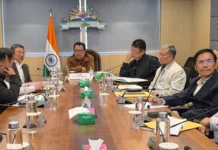[ Karto Ete ]
“They told me I won the election. But I never got to speak a word in the meetings.”
– A woman panchayat member, Arunachal Pradesh
In a remote corner of India’s democracy, a peculiar theatre unfolds every five years – called the panchayat elections. Women step into the spotlight, contesting seats that are constitutionally reserved for them. Their names appear on ballots. Their photos grace posters. Victory garlands adorn their necks. But behind the celebratory curtain, the script is often not their own.
Take, for instance, a woman recently elected as a zilla parishad member or ward member in Arunachal Pradesh. The village celebrated her win; she was hailed as a beacon of progress, a symbol of women’s empowerment. Yet, soon after the results were declared, the real decision-maker emerged – not her, but her husband. From attending meetings to signing documents and speaking to officials, he took over the reins. The elected woman was reduced to a rubber stamp – present in form, absent in function.
This is not an isolated incident. Across India – from Rajasthan to West Bengal, Bihar to Arunachal, including many parts of Northeast India, the phenomenon of the ‘sarpanch pati’ or ‘panchayat husbands’ is not just common, it’s normalized. The husbands, fathers, or brothers of elected women often become the de facto panchayat leaders. What was intended as a transformative policy for women’s political representation often becomes a puppet show, where men pull the strings while women stand silently beside them.
The 73rd Constitutional Amendment Act of 1992 mandated that not less than one-third of seats in panchayats be reserved for women. It was a historic move, meant to empower women at the grassroots level, to ensure their voice in governance, and to bring gender equity into local politics. However, the ground reality still struggles to catch up with that vision.
Studies by organisations such as the Centre for Social Research and the Ministry of Panchayati Raj reveal that in many regions, up to 60-70% of elected women representatives report interference by male family members in their official duties. In some cases, women are completely unaware of the decisions being made in their name.
Instead of empowering women to make decisions, reservation in many places has simply rearranged the stage. The name on the seat has changed, but the power structure hasn’t. The husband speaks while the wife sits silently beside him. The villagers nod, not in protest, but in familiarity. It’s the same play every election, just new faces in costume.
The tragedy here is not just of gender injustice but of lost potential. Many of these women, if given the opportunity and support, show remarkable leadership. There are examples of women sarpanchs who have tackled sanitation, health, and education issues with great resolve, when allowed to exercise real authority. But the system – often patriarchal, sometimes political, and always under-watched – prefers to keep them as symbolic figures, not active agents of change.
Why does this happen? One reason is societal conditioning. Many families view the reserved seat not as an opportunity for the woman, but for the household. The wife contests, but the husband runs the show. There is also a lack of capacity building – most elected women receive no training in administration or legal rights. Combine that with pressure from male-dominated village bodies, and you have a situation where women are neither encouraged nor equipped to lead.
In places like Arunachal, where traditional power structures and family hierarchies are deeply embedded, the challenge is even greater. The weight of custom is heavy – but not unmovable.
Yet change is possible. In some districts, we’ve seen women forming collectives to share their experiences, gain confidence, and push back against patriarchal control. NGOs and government initiatives that focus on training and mentoring women panchayat leaders have begun to show results. When given tools, support, and recognition, these women lead – not just capably, but admirably.
We need more leadership training, legal literacy workshops, and peer networks for elected women. Panchayat meetings must ensure that the elected member speaks – not their relative. Officials should stop recognizing or entertaining husbands in official capacities. Media can help by spotlighting real women leaders and calling out proxy cases.
Ultimately, the goal of women’s reservation is not just to change who sits in power, but who wields it. Until that happens, panchayat elections in many parts of India will remain political theatre, where the heroine is cast, but the hero steals the dialogue.
So the next time we cheer for another woman’s victory at the polls, let’s ask ourselves: Is she holding the mic – or just standing near it? And if not, what are we doing to change that? (The contributor is an alumnus of Rajiv Gandhi University, Rono Hills)



